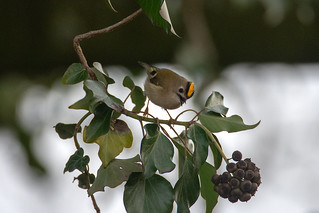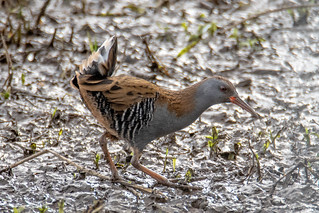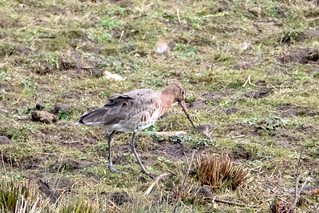Back from a working visit to the USA, we popped up to see our youngest at Keele University. While there we had a short walk around Wybunbury Moss National Nature Reserve and also Sandbach Flashes SSSI.

Our accommodation lay on the very edge of the Wybunbury Moss National Nature Reserve and so, at the end of our first day we popped down. Wybunbury Moss is a rare example of a "schwingmoor" or floating peat bog. This comprises a raft of peat, in some places only one metre in thickness, floating on a lake which itself is 13 metres in depth. The floating nature of the Moss is thought to have been created by the subsidence of underlying salt-bearing rocks, sometime in the last 5000 years.
As we went round there were a number of crow species, and a buzzard that flew off, landed ahead, and then flew off again each time we approached.  A pair of noisy mistle thrush flew in and out fir trees. An interesting place but not abundant in bird species and it wasn't until we got back up to our accommodation that we came across a pair of goldcrest, and a pair of nuthatch. As the light disappeared we heard a tawny owl towards the trees on the reserve.
A pair of noisy mistle thrush flew in and out fir trees. An interesting place but not abundant in bird species and it wasn't until we got back up to our accommodation that we came across a pair of goldcrest, and a pair of nuthatch. As the light disappeared we heard a tawny owl towards the trees on the reserve.
The following morning we left Ailsa to wake up and chill as she had a stinking cold. We drove the 9.5 miles to Sandbach Flashes and found a couple of cars already parked up on the verge.  Three people stood with scopes viewing the water from the Elton Hall Flash viewing area. From the car we looked at the water on the other side of the road spotting redshank, redwing and fieldfare. At the gate to the path leading to the viewing area, there was a very friendly water rail showing well; you couldn't get much better views.
Three people stood with scopes viewing the water from the Elton Hall Flash viewing area. From the car we looked at the water on the other side of the road spotting redshank, redwing and fieldfare. At the gate to the path leading to the viewing area, there was a very friendly water rail showing well; you couldn't get much better views.
From the viewing area we added a single close black-tailed godwit; eventually we had 8 on a very distant split. In front of them we had a mixed group of 10 m&f goosander. There were very large numbers of wigeon on the water and particularly in the fields beside. A flock of lapwing rose with gulls when spooked.
 On a distant bank we spotted a couple of sleeping pintail which eventually took to the water and swam with another two (3m&1f). Between them, and some teal and wigeon, a group of 14 snipe skulked.
On a distant bank we spotted a couple of sleeping pintail which eventually took to the water and swam with another two (3m&1f). Between them, and some teal and wigeon, a group of 14 snipe skulked.
I'm sure we will return when we visit our daughter again - passing time while she is at lectures.
Sightings at Sandbach Flashes (44) included: black-headed gull, black-tailed godwit, blackbird, blue tit, canada goose, carrion crow, chaffinch, collared dove, common gull, coot, cormorant, dunnock, fieldfare, goosander, great spotted woodpecker, great tit, grey heron, grey wagtail, herring gull, house sparrow, jackdaw, lapwing, lesser black-backed gull, long-tailed tit, magpie, mallard, moorhen, mute swan, pheasant, pintail, redshank, redwing, robin, shelduck, shoveler, snipe, song thrush, starling, teal, tree sparrow, tufted duck, water rail, wigeon and woodpigeon.
Additional to these, at Wybunbury Moss were: buzzard, goldcrest, greenfinch, mistle thrush, nuthatch and wren.

No comments:
Post a Comment